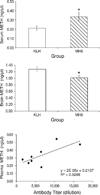A methamphetamine vaccine attenuates methamphetamine-induced disruptions in thermoregulation and activity in rats
- PMID: 23098894
- PMCID: PMC3561477
- DOI: 10.1016/j.biopsych.2012.09.010
A methamphetamine vaccine attenuates methamphetamine-induced disruptions in thermoregulation and activity in rats
Abstract
Background: There are no approved pharmacotherapies for d-methamphetamine (METH) addiction and existing therapies have limited efficacy. Advances in using immunotherapeutic approaches for cocaine and nicotine addiction have stimulated interest in creating a similar approach for METH addiction. This study investigated whether active vaccination against METH could potentially attenuate responses to METH in vivo.
Methods: Male Sprague Dawley rats (n = 32) received a four-boost series with one of three candidate anti-METH vaccines (MH2[R], MH6, and MH7) or a control keyhole limpet hemocyanin conjugate vaccine. Effects of METH on rectal temperature and wheel activity at 27°C ambient temperature were determined. The most efficacious vaccine, MH6, was then contrasted with keyhole limpet hemocyanin conjugate vaccine in a subsequent experiment (n = 16), wherein radiotelemetry determined home cage locomotor activity and body temperature at 23°C ambient temperature.
Results: The MH6 vaccine produced high antibody titers with nanomolar affinity for METH and sequestered METH in the periphery of rats. In experiment 1, the thermoregulatory and psychomotor responses produced by METH at 27°C were blocked in the MH6 group. In experiment 2, METH-induced decreases in body temperature and locomotor activity at 23°C were also attenuated in the MH6 group. A pharmacokinetic study in experiment 2 showed that MH6-vaccinated rats had higher METH serum concentrations, yet lower brain METH concentrations, than control rats, and METH concentrations correlated with individual antibody titer.
Conclusions: These data demonstrate that active immunopharmacotherapy provides functional protection against physiological and behavioral disruptions induced by METH.
Copyright © 2013 Society of Biological Psychiatry. Published by Elsevier Inc. All rights reserved.
Conflict of interest statement
The authors reported no biomedical financial interests or potential conflicts of interest.
Figures




References
-
- Kuehn B. FDA warns of adverse events linked to smoking cessation drug and antiepileptics. JAMA. 2008;10:1121–1122. - PubMed
Publication types
MeSH terms
Substances
Grants and funding
LinkOut - more resources
Full Text Sources
Other Literature Sources
Medical

